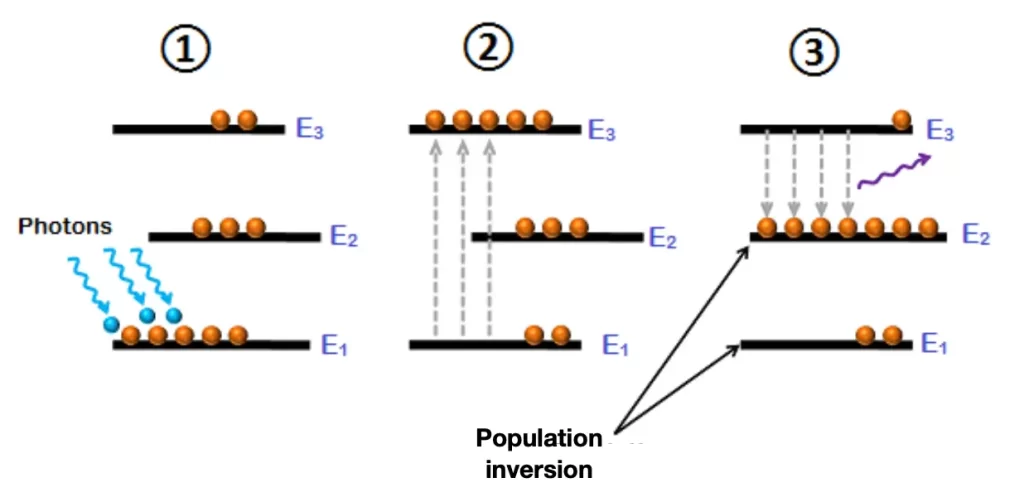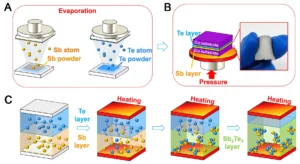

Once in the excited state, two things can happen to the atom:
- Spontaneous Emission: The atom can spontaneously decay back to the ground state, emitting a photon with energy in a random direction. This is illustrated in Figure (b).

This induces the atom to emit a photon that travels in the same direction as the incident photon. For each incident photon, a second photon is emitted in the same direction, resulting in an amplified and coherent beam of light. This process is shown in Figure (c).
Through stimulated emission, we can achieve an amplified, unidirectional, and coherent beam of light.
Metastable States: Definition and Explanation
A metastable state refers to an excited state of an atom, nucleus, or molecule that has a longer lifetime compared to other excited states. Unlike most excited states which quickly return to their ground state by emitting energy in the form of photons, a metastable state remains in this higher energy configuration for an extended period before decaying.

Key Characteristics of Metastable States:
- Extended Lifetime: The extended lifetime of metastable states, which can range from microseconds to even hours, is due to forbidden transitions. These transitions are highly unlikely under normal conditions, leading to a delay in the release of energy.
- Energy Barrier: There is usually an energy barrier that prevents the system from easily returning to its ground state, making the transition from the metastable state less probable.
- Application in Lasers: Metastable states are crucial in the functioning of lasers. They facilitate the accumulation of a population of atoms in the excited state, which is necessary for achieving population inversion—a fundamental requirement for laser operation.
Population Inversion in Lasers: Definition and Detailed Concept
Population inversion is a condition where more atoms or molecules in a material are in an excited state than in the ground state. This phenomenon is essential for laser operation, as it allows for stimulated emission to dominate over absorption, leading to coherent light amplification.
Steps to Achieve Population Inversion:

- Pumping: The process begins with pumping, where energy is supplied to the laser medium to excite electrons from the ground state to higher energy levels. Pumping can be achieved through various methods, such as optical pumping (using light), electrical pumping (using an electric current), or chemical reactions.
- Excitation to Higher Levels: Initially, electrons are excited to higher energy levels. These levels, however, are typically not metastable and thus quickly decay to lower energy states, including the metastable state, through non-radiative transitions.
- Accumulation in Metastable State: Due to the extended lifetime of the metastable state, electrons accumulate here, setting up a situation where more electrons are in the excited metastable state than in the ground state.
- Achieving Population Inversion: Once a sufficient number of electrons are in the metastable state compared to the ground state, population inversion is achieved.
Stimulated Emission:
- In the presence of an external photon of specific energy, an electron in the metastable state can be stimulated to drop to a lower energy state, emitting a photon in the process.
- This emitted photon will have the same phase, frequency, direction, and polarisation as the stimulating photon, leading to coherent light amplification.
- The chain reaction of stimulated emissions, where each emitted photon stimulates further emissions, results in a coherent and intense beam of light—a laser.
Importance of Population Inversion:
- Without population inversion, the rate of absorption (electrons moving from lower to higher energy states) would exceed the rate of stimulated emission, making light amplification impossible.
- Population inversion ensures that stimulated emission dominates, allowing the laser to function efficiently.
Laser Cavity and Amplification:
- The laser cavity, typically consisting of two mirrors facing each other with the laser medium in between, plays a critical role in sustaining the amplification process.
- Photons bouncing back and forth between the mirrors repeatedly pass through the medium, stimulating more emissions and amplifying the light.
- One of the mirrors is partially transparent, allowing the amplified light to escape as a coherent laser beam.
Conclusion
The concepts of metastable states and population inversion are fundamental to the operation of lasers. Metastable states enable the buildup of a significant population of excited atoms, while population inversion ensures that stimulated emission can dominate, leading to light amplification. Understanding these principles provides insight into the sophisticated mechanisms underlying laser technology, which has become indispensable in various fields including medicine, communication, manufacturing, and research.




